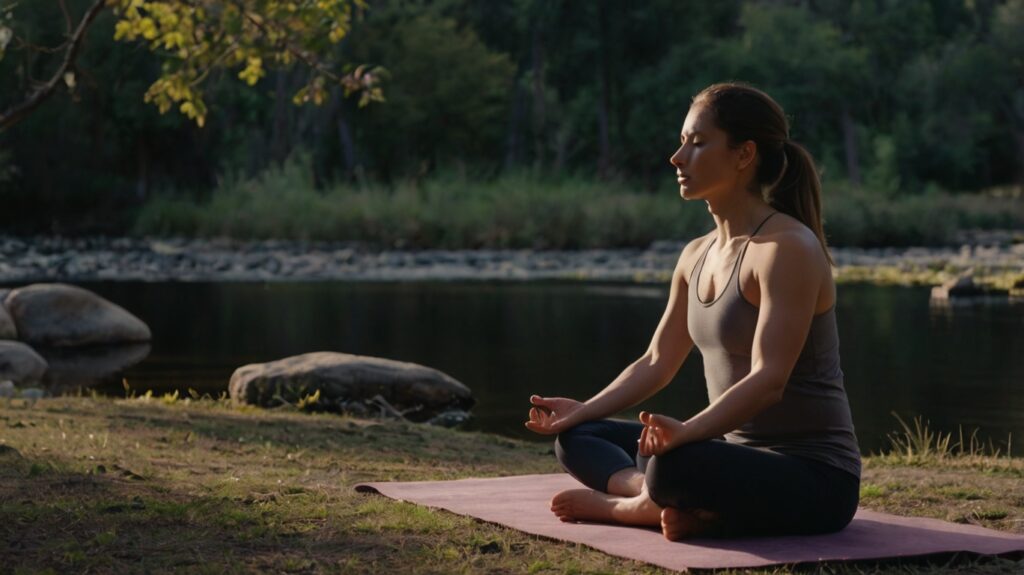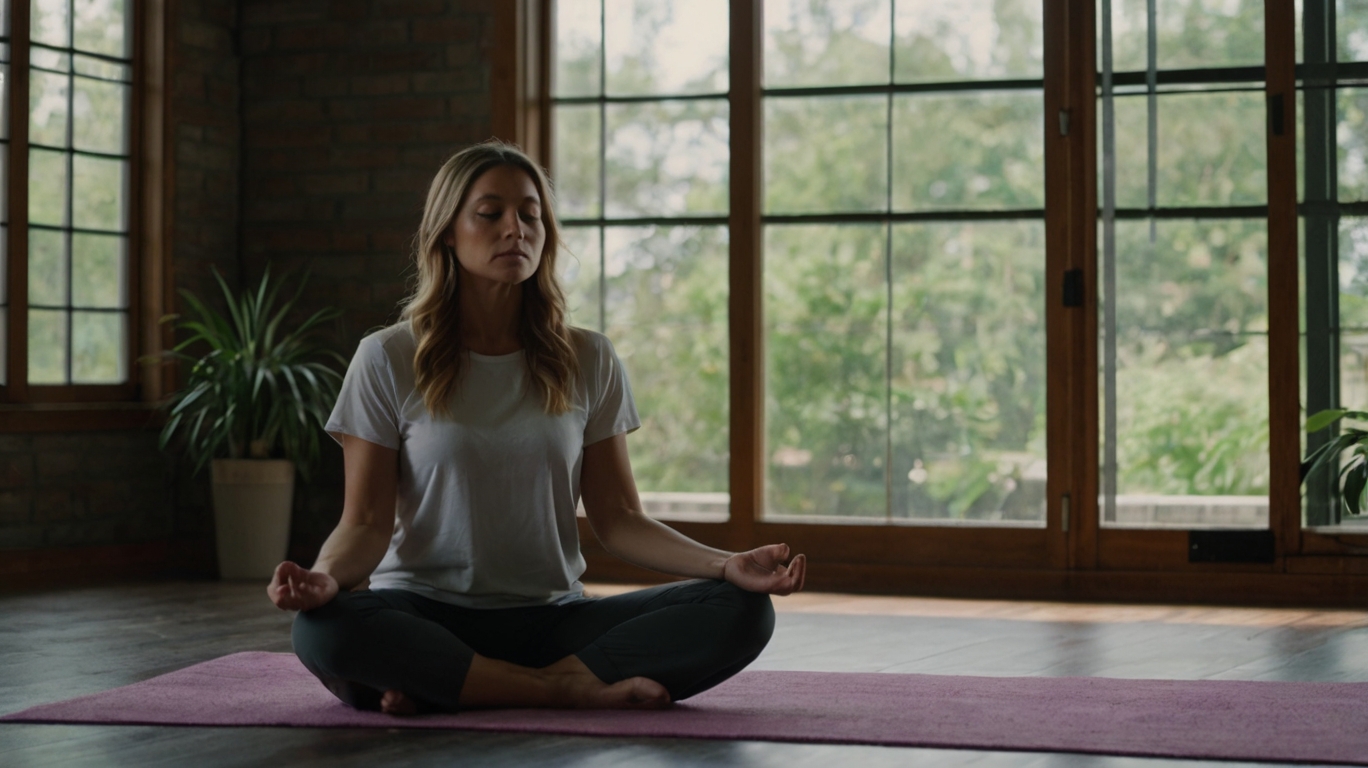Preparing Your Meditation Space

The foundation of a successful meditation starts with your space. Want to know the secret to a great 5- minute meditation? Turn your phone off. Not on silent—actually off. Or at least in another room. Those notifications are meditation kryptonite.
Find a spot where people won’t walk through. Morning meditators know this well—wake up 15 minutes before everyone else and claim that peaceful corner. If you live with others, a simple “Please don’t disturb” note works wonders.
Noise can be tricky. Some people need complete silence, while others find silence deafening. If outside sounds bother you, try a white noise machine or soft nature sounds that blend into the background rather than grabbing your attention.
Optimal Seating and Posture Options
Forget what you’ve seen in magazines—you don’t need to twist into a pretzel to meditate properly. The best position is simply one you can maintain comfortably for 5 minutes without fidgeting.
A chair works perfectly fine! Sit toward the front edge with your feet flat on the floor. This keeps your spine naturally aligned without strain.
Floor-sitters have options too:
Cushion or folded blanket under your sit bones
Cross-legged position or half-lotus if comfortable
Back straight but not rigid
Hands resting on thighs or in your lap

Setting a Timer Without Disruptions
The last thing you need is a jarring alarm yanking you out of tranquility. Most meditation apps offer gentle
bells or chimes that ease you back to awareness Meditation .
If using your phone, activate airplane mode first Meditation. This prevents calls or notifications from interrupting your practice .
For a truly peaceful experience, try a dedicated meditation timer or an old-school sand timer that makes no sound at all—just a visual cue when your practice is complete.
Customizing Your Meditation Experience
Adapting the Script for Different Needs
Your five-minute meditation doesn’t have to be one-size-fits-all. The beauty of a simple script is how easily you can tweak it to fit what you’re going through.
Feeling anxious? Focus your body scan on areas where you hold tension—typically the jaw, shoulders, and chest. Replace general relaxation cues with specific ones like “release the tightness in your shoulders as they melt away from your ears.”
Need energy? Shift your breathing pattern to more invigorating techniques. Try “breathe in for 4, hold for 2, exhale for 4” instead of longer exhales that calm you down.
Having trouble sleeping? Extend the exhale portions and use phrases like “heavy,” “sinking,” and “releasing” while eliminating energizing language.
Adding Background Sounds or Music
Background sounds aren’t just nice—they can transform your practice. Your brain actually processes sound differently during meditation.
The right soundtrack drops you deeper faster:
Nature sounds: Rain, ocean waves, or forest sounds mask distractions
Singing bowls: Their frequency helps align your brainwaves
White noise: Creates a consistent sound blanket that blocks interruptions
Instrumental music: Slow tempo pieces (under 60 BPM) naturally slow your breathing
Don’t overthink it. Pick something that doesn’t grab your attention but supports your background
awareness.

Seasonal and Time-of-Day Variations
Our bodies respond differently depending on when and where we meditate. Smart meditators adjust accordingly.
Morning meditations work best with:
Slightly faster pace
Visual imagery involving light
Forward-focused intentions
Evening practices benefit from:
Slower delivery
Grounding imagery
Reflection-based awareness
Seasonal tweaks matter too. Winter meditations might include warmth imagery, while summer ones could incorporate cooling visualizations. Spring practices often work well with growth themes, and fall meditations naturally pair with letting-go metaphors.
Your body already knows the rhythm of the day and year—your meditation should follow along.
Recording and Sharing Your Meditation Script
Voice Recording Best Practices
Got a script you love? Time to bring it to life with your voice! Recording quality matters—it can make or break your meditation experience.
First, find a quiet spot. I mean dead quiet. That means no dishwasher humming, no kids yelling, no cars honking outside. Even small background noises get amplified on recordings.
Use a decent microphone. Your phone can work, but a simple USB mic (even a $30 one) will sound dramatically better. Position it about 6-8 inches from your mouth.
Speak slower than feels natural. First-time recorders always rush. Take deep breaths between sentences and maintain a steady, soothing rhythm.
Try this trick: record a practice run, listen back, and mark spots where you rushed. Then re-record with intentional pauses where needed.
Digital Platforms for Sharing Meditations
Once recorded, you’ve got options for sharing your meditation:
Insight Timer: The meditation community hub with 19+ million users
Spotify/Apple Podcasts: Create a simple podcast feed
YouTube: Add a static image to your audio
SoundCloud: Perfect for audio-only content
Most platforms let you upload directly from your phone. For YouTube, you’ll need to pair your audio with a simple image—even just a calming nature photo works wonderfully.
Getting Feedback to Improve Your Script
Feedback is gold when refining your meditation script. Start with trusted friends—not just anyone, but people who actually meditate.
Create a simple Google Form asking specific questions:
Was the pacing too fast or slow?
Did any words or phrases feel jarring?
Were the instructions clear?
How did you feel afterward?
Join meditation teacher groups on Facebook or Reddit to get input from experienced practitioners. Just
be prepared—feedback might sting at first, but it’s the fastest path to improvement.
Test different versions with small tweaks to see what resonates. Sometimes changing just a few transition phrases makes all the difference.

Taking just five minutes out of your busy day for meditation can have profound effects on your mental well-being. By creating a calming space, following a simple guided script, and adapting it to your personal needs, you can establish a meaningful meditation practice that fits into even the most hectic schedule. Whether you’re focusing on breath awareness, body scanning, or gratitude, these short sessions can help reduce stress and increase mindfulness.
Don’t hesitate to record your personalized meditation script or share it with others who might benefit. Remember that consistency matters more than duration—a regular five-minute practice can transform your relationship with stress and help you cultivate greater peace in your daily life. Start your meditation journey today and discover how these small moments of stillness can create lasting positive change.










